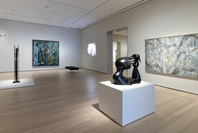Upon their appearance in the mid-1940s, Maya Deren's films were described by New York Times dance critic John Martin as "choreocinema," a happy neologism that attempted to account for two of Deren's thematic preoccupations: the human body in motion and the filmmaking process itself. Her first two films, Meshes of the Afternoon (1943) and At Land (1944), began this endeavor (if only partially), but it was in her third project, Study in Choreography for Camera, that Deren fully realized her vision of freeing the human body from the confines of theatrical—and actual—space. In Study, a dancer (Talley Beatty) moves effortlessly within and between different environments (forest, living room, museum gallery, etc.), an achievement arrived at through the careful matching of his precisely choreographed movements with the film's editing pattern. As Beatty leaps from space to space across Deren's film splices, a new geographical reality is created, one where great distances can be covered within the span of just four minutes. Beatty's disciplined performance never betrays the difficulties that he and his director must have overcome to attain so fluid a result. Deren's camera, in effect, becomes Beatty's partner.
Publication excerpt from Steven Higgins, Still Moving: The Film and Media Collections of the Museum of Modern Art, New York: The Museum of Modern Art, 2006, p. 199.



